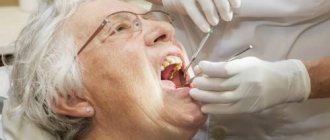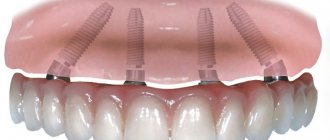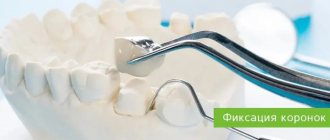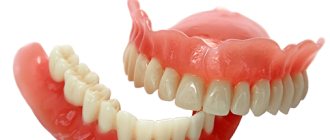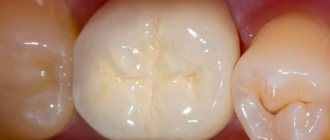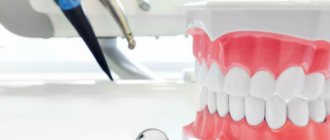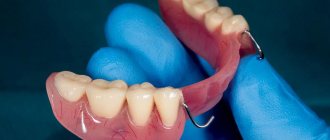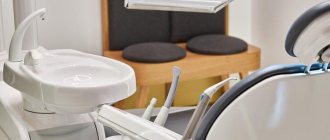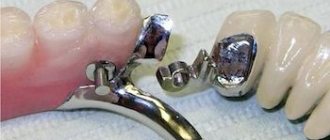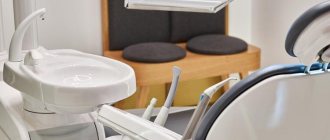Description of the main characteristics of alloys
Hardness as the property of a material to resist the penetration of an indenter—another solid body—into it. This parameter determines the occlusal wear resistance and how the dentist can process and polish the prosthesis.
The yield stress is the stress required to cause permanent plastic deformation in tension. The proof strength is the stress that occurs at a strain of 0.2%. This parameter characterizes the strength of the alloy more than others. This is what people pay attention to first when choosing the design of a prosthesis.
The elastic modulus is another important property that determines the flexibility of a metal frame. An alloy with a high modulus of elasticity bends less under load than an analogue with a low modulus.
Elongation is the ductility of a material, measured as a percentage. The lower this indicator, the more fragile the alloy will be.
The melting temperature range is an important parameter to prevent frame deformation when firing ceramics.
Biocompatibility means that the alloy material is safe for the tissues of the body and humans in general. Non-noble alloys have mixed biocompatibility and should be used with caution.
Manufacturability is the maximum precision in manufacturing and processing of the frame.
The coefficient of thermal linear expansion indicates the compatibility of the alloy with ceramics. The main condition is that the coefficients of the alloy and ceramics must match as much as possible, and there should be no residual stress left in the finished restoration.
Technological aspects of metal ceramics
In the process of manufacturing metal-ceramic structures, there are a number of key points that deserve special attention.
- Tooth preparation for metal ceramics.
- The tooth must be prepared (ground) with a ledge at the gum level.
- The total thickness of the metal frame and the ceramic mass covering it is about 1.5 mm. As a result, if the tooth is ground without a ledge, we get the edge of the crown hanging over the gum and pressing on it. The crown presses against the blood vessels and a “bruise” forms. The metal frame comes into direct contact with the gum, and metal ions cause it to darken.
- In the case of preparation with a shoulder, the edge of the metal-ceramic crown rests on the hard tissues of the tooth without injuring the mucous membrane. This technology is quite labor-intensive, and its implementation requires a modern dental unit and, of course, the qualifications of a doctor and dental technician.
- The intermediate part of the metal-ceramic bridge prosthesis should also not put pressure on the mucous membrane (gum), otherwise bedsores may form. Of course, in those places where it is visible, you have to make a compromise, but in any case the touch should be very gentle. And if food gets into a place where there is a loose seal, it will be much easier to remove it from there than in the case of the “full contact” option.
- Many doctors “sin” by depulping (removing the nerve of the tooth) even healthy teeth under metal-ceramics, which is not always justified, since modern technologies make it possible in many cases to avoid this procedure. Depulped (dead) teeth cannot resist infection and often have to be re-treated. In addition, a pulpless tooth becomes more fragile and can collapse under a heavy metal-ceramic structure.
Properties of noble alloys
The ideal option, according to most dentists, is expensive gold-platinum alloys. They have impeccable mechanical and physical properties, high biocompatibility and are well combined with ceramics. The most famous noble alloys produced in Russia are “Plagodent” and “Plagodent Plus”.
Palladium in combination with gold forms alloys with excellent physical and mechanical properties and high corrosion resistance. They have a decent yield strength and high tensile strength, so long bridges and permanent elements of locking joints are made from them. In appearance they resemble base alloys. Only 10% palladium in the composition gives the alloy a white color, similar to steel.
Working with palladium structures requires certain skills from the dentist due to the high melting point of the alloy and special casting techniques. Soldering and laser welding should be avoided. Gold-palladium alloys are cheaper than gold-platinum alloys: due to different densities, the difference in cost can reach 2-2.5 times.
The percentage of noble metal in the alloy affects corrosion resistance and biocompatibility. The cost of a prosthesis can only be reduced by switching to non-precious alloys. A noble alloy may contain a high or low gold content, or may not contain this element at all, as, for example, in silver-palladium compositions.
Indications and restrictions
According to statistics, when it is necessary to restore a badly damaged coronal part and reinforce the root of a tooth, core inlays are used in 70-80% of cases.
The use of any structures, including silver ones, is indicated in the following cases:
- Severe destruction of the crown part of the tooth while maintaining the roots in satisfactory condition.
- Enamel hypoplasia.
- Anomaly in tooth shape and/or position.
Satisfactory condition of the roots implies:
- lack of mobility above the 1st degree;
- sufficient root length (it is advisable to have a ratio with crown height of at least 1.5:1);
- the thickness of the walls of the treated root canals is at least 1 mm;
- absence of cysts and inflammatory processes in the periodontium;
- significant curvature and ornateness of the canal that impedes processing (at least 16 mm in the mouth and middle part of the root of a single-rooted tooth and 10 mm of a multi-rooted tooth must be straight);
- lack of canal bone resorption;
- the deviation of the axes of the root and crown parts of the tooth from each other is no more than 15%.
Stump inlays made of silver alloy are contraindicated in the following cases:
- the presence of metal products in the mouth that can create a galvanic couple with a silver alloy;
- The patient is allergic to silver.
What determines the color of noble alloys?
Doctors pay attention to color. It is believed that a very yellow alloy containing a lot of gold improves the color of ceramics: the oxides of such alloys are easily coated with a thin layer of opaque and look aesthetically pleasing. A patient who observes the golden color of the crown frame at intermediate stages has no doubt about the need to purchase such an expensive prosthesis.
In some noble alloys, the proportion of palladium, platinum or silver is increased, so they lose their yellow color, but remain just as strong. Such varieties are suitable for the manufacture of extended bridges, with or without implant support. If you are going to install a single crown, you can get by with an option with a high gold content and a low content of platinum group metals.
Alloys with fewer noble components have a pronounced yellow color and do not have such good properties as white alloys. They contain a high content of indium, which in combination with palladium gives a bright straw color. They do not have sufficient elasticity and corrosion resistance. They are used mainly in China and India on a massive scale to reduce the cost of dentures.
What are dentures made from?
Modern dental prostheses differ from each other in aesthetic and functional parameters. Today, dentists use materials that are safe for the body and convenient to work with, with the help of which they can achieve the effect necessary for the patient and his health:
- composite;
- ceramics;
- metal ceramics;
- oxide, zirconium dioxide;
- metal alloys;
- plastic (acrylic, nylon).
Three types of base alloys
Chromium alloys have been used in dentistry for more than eighty years. They are characterized by good corrosion resistance, strength, high modulus of elasticity, low density and affordable price.
- Nickel-chrome-containing alloys are used more often for frames for the purpose of further cladding. They contain 62-82% nickel and 11-22% chromium, as well as additives - molybdenum, silicon, manganese, iron, gallium, titanium, zirconium.
- Cobalt-chrome alloys contain 50-65% cobalt, 25-35% chromium and 2-6% molybdenum with rare exceptions.
The melting point of these alloys is between 1140 and 1460 °C. The polished surfaces of the dentures are shiny, silvery-white. Light weight, density slightly exceeds 8 g/cm3. Such alloys are excellent for installing single-type crowns and bridges on teeth; they are stronger and harder than noble alloys, but require the use of special abrasive tools during machining. Occlusal correction, polishing and removal of dentures cause certain difficulties and require much more time.
The bond between ceramics and metal is as strong as that of noble alloys. Casting is less precise, which is not noticeable on small castings. The issue of biocompatibility is questionable. Nickel and chromium are strong allergens.
- Titanium alloys have low density, excellent mechanical properties, high biocompatibility and corrosion resistance. However, casting titanium alloys for the manufacture of fixed prostheses has become obsolete due to the high cost and technological complexity of the process. Milling is much more often used.
In order to save money, stainless steel is increasingly being used for the manufacture of fixed dentures. Stamped crowns are characterized by their low cost and minimal amount of tooth preparation. In foreign dentistry they are used for temporary prosthetics of baby teeth.
Definition of structure
Using microscopic and macroscopic analyses, you can find out the structure of metals. Macroanalysis helps determine:
- micro- and macroscopic metal defects;
- chemical composition (heterogeneity of various alloy elements);
- structure (heterogeneity of alloys resulting from heat treatment).
Thanks to the microscopic method of examination, it is possible to establish:
- the shape and dimensions of any structural elements of the alloy;
- microcracks that violate the integrity of the material;
- structures typical for certain processing methods;
- additives of non-metallic origin;
- a change in structure that occurs under thermal influence.
Experts' opinion
While paying tribute to the strength and bactericidal properties of silver-palladium alloys, some dentists generally rate this material negatively due to its ability to form galvanic pairs with other metals.
Patients who develop galvanism due to galvanic currents experience a bitter and burning sensation in the mouth. Swelling and hyperemia of the gums appear. Saliva becomes foamy and viscous.
Unpleasant sensations intensify with prolonged conversation and decrease after rinsing. Symptoms of galvanism develop approximately 2-3 months after installation of a metal-ceramic crown on a stump inlay made of a silver alloy. In such cases, the patient is sent to measure galvanic currents.
This can be done, as well as other tests for intolerance to orthopedic materials and allergic reactions, in specialized laboratories. The potential difference in the oral cavity should not exceed 100 mV.
It is recommended to use gold or cobalt-chromium alloys for casting the stump insert. These are the materials with the most suitable combination of characteristics. In general, it is necessary that all artificial parts of the tooth are made of the same alloy.
Installation details
The technology for installing collapsible core inlays (in multi-rooted teeth) differs significantly from fixing solid ones (in single-rooted teeth).
In multi-root structures, only one pin is cast integrally with the stump. The rest are made separately by the technician and installed in the holes of the stump and the canals of the tooth during the final fixation of the inlay.
In general, installation of a pin insert on a tooth is performed in the following sequence:
- Rinsing the tooth canals with sodium hypochlorite and drying.
- Fitting of the stump tab and individual pins (for multi-root construction), modification if necessary.
- Lubricating the pins with fixing cement, for example, GC FujiCem.
- Installation and fixation of the inlay and individual pins on the tooth.
- Taking an impression from the stump.
- Making a crown from an impression. It must be made from the same material as the stump insert, that is, in our case, from a silver-palladium alloy, for example, PD-190.
- Fitting the crown, adjusting it, fixing it with cement.
In some cases, immediately after fixing the structure, a temporary crown is installed on the stump, which is made simultaneously with the inlay. It is worn during the period required to make a permanent crown.
Watch the video to learn how to prepare a tooth for a stump inlay.
Manufacturing stages
A significant number of stringent requirements for the condition of the tooth root when using core inlays requires careful diagnosis. In addition to examining the oral cavity, radiography is necessary to show the detailed condition of the root canals.
If the results of the study satisfy all the requirements, tooth preparation begins. Making a tab includes the following operations:
- Tooth anesthesia.
- Removal of the damaged part of the crown.
- Cleaning and filling of the dental canal (the apical part of 3-5 mm must be reliably obturated).
- Formation of channels for the inlay pins with a depth of approximately 2/3 of the channel depth. The walls are processed with a slight taper; excessive expansion should be avoided.
Further actions depend on the protocol used. The production of a stump inlay can be done by direct and indirect methods.
The first involves modeling the structure directly in the patient’s mouth. The canal and part of the coronal cavity of the tooth are filled with burnable modeling material.
At a time when only wax was used as a modeling material, this operation was difficult due to its softness. It was difficult to remove the wax model from the canal without damaging it.
Therefore, the direct modeling method became widely developed only with the advent of technologically advanced ashless modeling plastics that retain their shape well. In particular, the material GC Pattern Resin LS.
The indirect method of making an inlay consists of taking an impression from the prepared canal and the crown part of the tooth and transferring it to the laboratory, where a model is made from it.
The inlay is cast from a silver alloy using a lost wax model and handed over to the orthopedist for fitting and installation.


